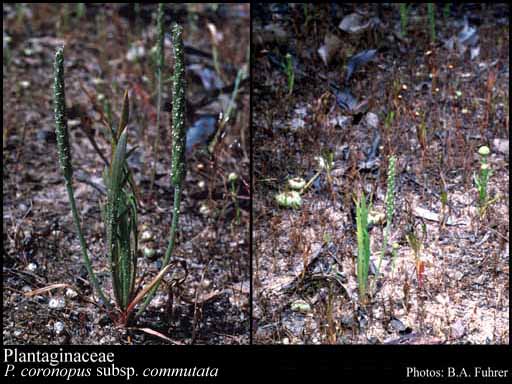- Reference
- Gen.Pl. [Jussieu] 89 (1789)
- Name Status
- Current

Scientific Description
Common name. Plantain Family.
Habit and leaf form. Herbs (mostly), or shrubs. Plants succulent (e.g. Plantago maritima), or non-succulent. Annual to perennial; plants with a basal concentration of leaves, or with neither basal nor terminal concentrations of leaves. Sometimes pachycaul. Helophytic to xerophytic. Heterophyllous, or not heterophyllous. Leaves alternate; spiral; ‘herbaceous’, or leathery, or fleshy (occasionally); petiolate to sessile (the blade/petiole distinction never clear); sheathing. Leaf sheaths not tubular; with free margins. Leaves simple; epulvinate. Leaf blades entire (usually), or dissected; linear (sometimes ericoid), or lanceolate, or oblanceolate, or ovate, or orbicular; when dissected, more or less pinnatifid; parallel-veined; cross-venulate. Leaves without stipules. Leaf anatomy. Hydathodes present (commonly), or absent. Stem anatomy. Nodes unilacunar, or tri-lacunar, or multilacunar. Secondary thickening absent, or developing from a conventional cambial ring.
Reproductive type, pollination. Fertile flowers hermaphrodite, or hermaphrodite and functionally female, or functionally male and functionally female. Unisexual flowers present, or absent. Plants hermaphrodite, or gynomonoecious, or monoecious. Anemophilous, or anemophilous and entomophilous.
Inflorescence and flower features. Flowers aggregated in ‘inflorescences’; in spikes, or in heads. The terminal inflorescence unit racemose. Inflorescences scapiflorous (at least, pedunculate); terminal; heads or spikes. Flowers bracteate; ebracteolate; small; regular; (3–)4 merous; cyclic; tetracyclic. Free hypanthium absent. Hypogynous disk absent. Perianth with distinct calyx and corolla; (6–)8; 2 -whorled; isomerous. Calyx (3–)4 (the posterior sepal seemingly lacking); 1 -whorled; gamosepalous, or partially gamosepalous; imbricate. When ostensibly only partially gamosepalous, 2 of the members joined (the abaxial pair). Calyx regular (diagonal); persistent. Corolla (3–)4 (the two posterior petals fused?); 1 -whorled; gamopetalous; imbricate (membranous); regular, or unequal but not bilabiate (the lobes unequal in Bougueria). Androecium present, or absent (when female). Fertile stamens present, or absent (from female flowers). Androecium (1–)4. Androecial members adnate (to the corolla); all equal; free of one another; 1 -whorled. Androecium exclusively of fertile stamens. Stamens (1–)4; reduced in number relative to the adjacent perianth to isomerous with the perianth; oppositisepalous. Anthers dorsifixed; versatile; dehiscing via longitudinal slits; introrse. Fertile gynoecium present, or absent (male flowers). Gynoecium 2 carpelled. The pistil 2 celled. Carpels reduced in number relative to the perianth. Gynoecium syncarpous; synstylovarious to eu-syncarpous; superior. Ovary plurilocular; 2 locular. Gynoecium median; stylate. Styles 1; attenuate from the ovary; apical. Stigmas usually 2 - lobed; dry type; non-papillate; Group II type. Placentation axile (Plantago), or basal. Ovules 5–50 per locule (i.e. to many, in Plantago), or 1 per locule; peltate; non-arillate; hemianatropous, or anatropous, or campylotropous.
Fruit and seed features. Fruit non-fleshy; dehiscent, or indehiscent; a capsule (membranous), or a nut. Capsules circumscissile. Seeds copiously endospermic. Cotyledons 2. Embryo achlorophyllous (6 species of Plantago); straight (usually), or curved. Seedling. Germination phanerocotylar.
Physiology, biochemistry. Aluminium accumulation not found. Photosynthetic pathway: C3.
Geography, cytology, number of species. World distribution: cosmopolitan. X = 4–12(+). 270 species.
Economic uses, etc. Widespread weeds, and a laxative from P. psyllium seed.